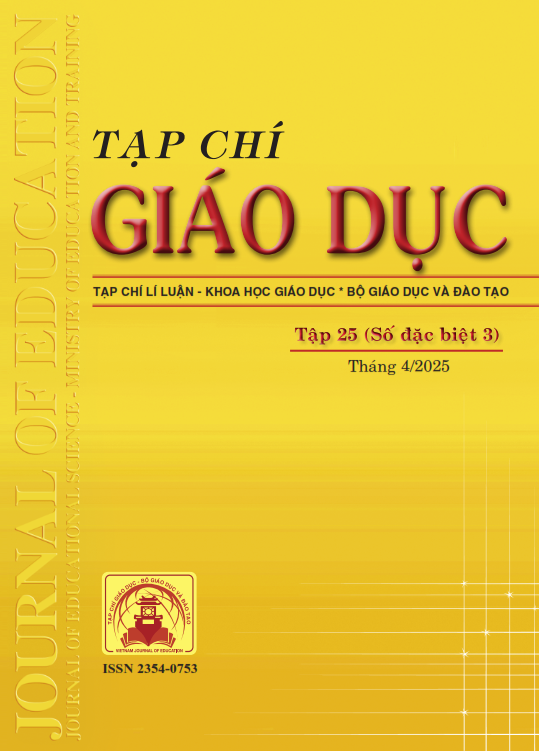Xây dựng ứng dụng thực tế ảo tăng cường trong dạy học kiến thức về sóng dọc và sóng ngang (Vật lí 11)
- Từ khóa:
- Augmented reality
- physics
- longitudinal
- transverse
Tóm tắt
When teaching the concepts of transverse and longitudinal waves, teachers face many challenges in helping students visualize and understand the abstract nature of wave propagation. The application of augmented reality (AR) technology is a new approach with the desire to help students access 3D models of transverse and longitudinal waves in the real world. In this study, we use the MDLC (Multimedia Development Life Cycle) method to develop TransLong WavesAR software on the Android platform with the aim of applying AR technology to place 3D models into the real world with the objects: longitudinal waves on a spring, longitudinal waves on a string, longitudinal waves on an elastic rod, longitudinal waves in air, transverse waves on an elastic rod, transverse waves on a string, and transverse waves propagating on water. From the effectiveness of the TransLong WavesAR application, we believe that future research will provide toolkits for educational purposes based on AR technology.
Tài liệu tham khảo
Bacca Acosta, J. L., Baldiris Navarro, S. M., Fabregat Gesa, R., & Graf, S. (2014). Augmented reality trends in education: a systematic review of research and applications. Journal of Educational Technology and Society, 17(4), 133-149.
Chaudhary, M., Singh, G., Gaur, L., Mathur, N., & Kapoor, S. (2023). Leveraging Unity 3D and Vuforia Engine for Augmented Reality Application Development. In 2023 3rd International Conference on Technological Advancements in Computational Sciences (ICTACS) (pp. 1139-1144). IEEE.
Chow, S., Krueger, K., & Oyekoya, O. (2023). iOS Augmented Reality Application for Immersive Structural Biology Education. Companion Proceedings of the 2023 Conference on Interactive Surfaces and Spaces, (pp. 14-18).
Hakim, A. R., Hasibuan, A. R., & Hariani, P. P. (2024). Implementation of Multimedia Development Life Cycle in Learning Media Applications for Children with Mental Disabilities. Hanif Journal of Information Systems, 2(1), 11-21.
Johnson, L., Becker, S. A., Cummins, M., Estrada, V., Freeman, A., & Hall, C. (2016). NMC horizon report: 2016 higher education edition. The New Media Consortium.
Kumala, F., Ghufron, A., Astuti, P., Crismonika, M., Hudha, M., & Nita, C. (2021). MDLC model for developing multimedia e-learning on energy concept for primary school students. Journal of Physics: Conference Series (Vol. 1869, No. 1, p. 012068). IOP Publishing.
Pricilia, A., Abdurrahman, A., & Herlina, K. (2020). Teacher expectation towards interactive multimedia integrated with STEM in learning physics: Preliminary study on geometry optic learning material. Journal of Physics: Conference Series (Vol. 1572, No. 1, p. 012065). IOP Publishing.
Singh, S., & Kaur, A. (2022). Game development using unity game engine. In 2022 3rd International Conference on Computing, Analytics and Networks (ICAN) (pp. 1-6). IEEE
Solehatin, S., Aslamiyah, S., Pertiwi, D. A. A., & Santosa, K. (2023). Augmented reality development using multimedia development life cycle (MDLC) method in learning media. Journal of Soft Computing Exploration, 4(1), 30-38.
Vázquez-Cano, E., & Sevillano García, M. L. (2018). Ubiquitous educational use of mobile digital devices. A general and comparative study in Spanish and Latin America higher education.
Villalustre, L., & Del Moral, M. (2016). Experiencias interactivas con realidad aumentada en las aulas. Barcelona: Octaedro.
Đã Xuất bản
Cách trích dẫn
Số
Chuyên mục
Giấy phép

Tác phẩm này được cấp phép theo Ghi nhận tác giả của Creative Commons Giấy phép quốc tế 4.0 .












